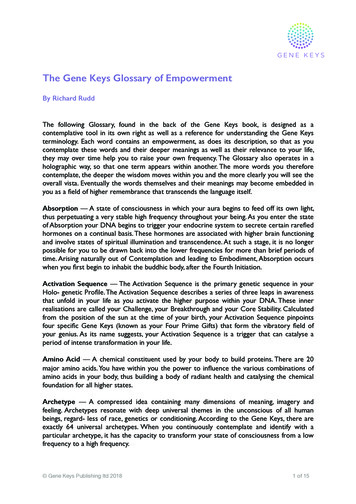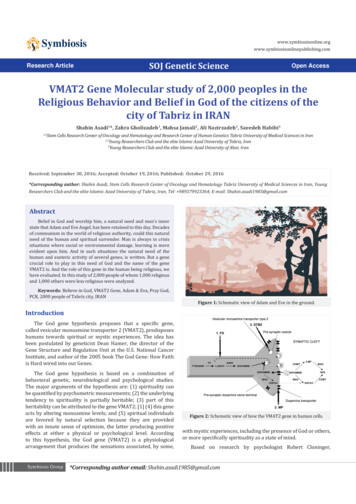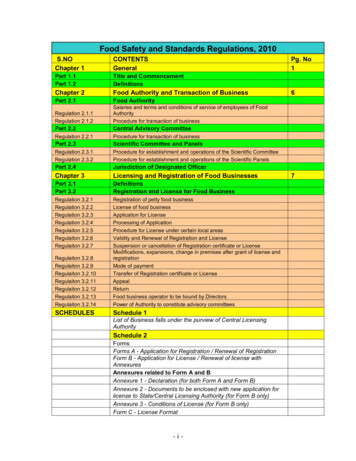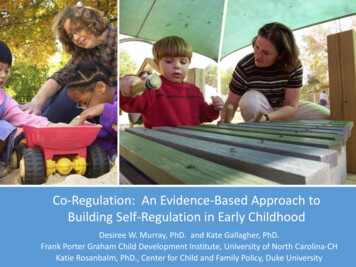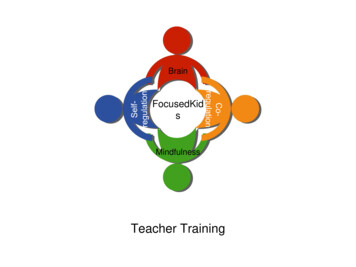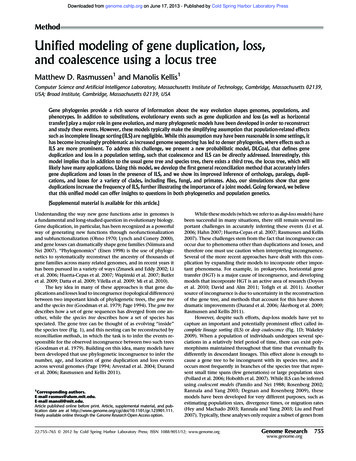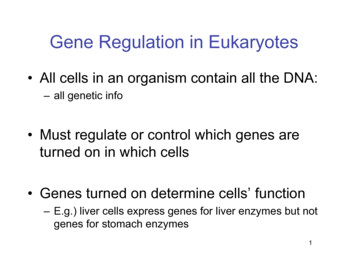
Transcription
Gene Regulation in Eukaryotes All cells in an organism contain all the DNA:– all genetic info Must regulate or control which genes areturned on in which cells Genes turned on determine cells’ function– E.g.) liver cells express genes for liver enzymes but notgenes for stomach enzymes1
Proteins act in transDNA sites act only in cis Trans acting elements (not DNA) can diffusethrough cytoplasm and act at target DNAsites on any DNA molecule in cell (usuallyproteins) Cis acting elements (DNA sequences) canonly influence expression of adjacent geneson same DNA molecule2 /27
Eukaryotic Promoterstrans-acting proteins control transcription fromclass II (RNA pol II) promoters Basal factors bind tothe core promoter– TBP – TATA box bindingprotein– TAF – TBP associatedfactors RNA polymerase IIbinds to basalfactors3Fig. 17.4 a
Eukaryotic Promoters Promoter proximal elements are required for highlevels of transcription. They are further upstream from the start site, usuallyat positions between -50 and -500. These elements generally function in eitherorientation. Examples include:– The CAAT box consensus sequence CCAAT– The GC box consensus sequence GGGCGG– Octamer consensus sequence AGCTAAAT4
Regulatory elements that map near agene are cis-acting DNA sequencesCore cis-acting elements– Core Promoter – Basal level expression Binding site for TATA-binding protein and associated factors– Promoter Proximal Elements - True level of expression Binding sites for transcription factors5
Eukaryotic Promoter Elements Various combinations of core and proximal elementsare found near different genes. Promoter proximal elements are key to geneexpression.– Activators, proteins important in transcription regulation, arerecognized by promoter proximal elements.– Housekeeping genes used in all cell types for basic cellular functions have common promoter proximal elements are recognized by activator proteins found in all cells.– Genes expressed only in some cell types or at particular times havepromoter proximal elements recognized by activator proteins foundonly in specific cell types or times.6
Eukaryotic Enhancer Sequences Enhancers are another cis-acting element. They are required for maximal transcription of agene.! Enhancers can be upstream or downstream of the transcriptioninitiation site! They may modulate from a distance of thousands of base pairs awayfrom the initiation site.! Enhancers contain short sequence elements, some similar topromoter sequences.! Activators bind these sequences and other protein complexes form,postulated to bring the enhancer complex close to the promoter andincreasing transcription.7
Regulatory elements that map near agene are cis-acting DNA sequences cis-acting elements– Promoter – very close to gene’s initiation site– Enhancer can lie far way from gene Can be reversed Augment or repress basal levels of transcription8
Regulatory elements that act on the promoter orenhancer sequences are trans-acting factors Genes that encodeproteins that interactdirectly or indirectlywith target genes cisacting elements– Known genetically astranscription factors– Identified by: Mapping Biochemical studiesto identify proteinsthat bind in vitro tocis-acting elements9
How do Enhancers work if they are so faraway from the promoter? Possible looping of DNA Brings transcription factors together10
Transcription Factors Also called activator proteins and silencer proteins Bind to promoter, enhancer, and silencer DNA inspecific ways Interact with other proteins to activate and increasetranscription as much as 100-fold above basallevels– or repress transcription in the case of silencers/repressors Two structural domains mediate these functions– DNA-binding domain– Transcription-activator domain11
Transcription Factors Transcriptionalactivators bindto specificpromoters andenhancers atspecific times toincreasetranscriptionallevelsFig. 17.5 a12
Examples of common transcription factors zinc-fingerproteins helix-loop-helixproteins bind topromoter andenhancer DNA through theirDNA-bindingdomains13
Some proteins affect transcription withoutbinding to DNA Coactivator –– binds to and affects activator protein which binds to DNA– Does not itself bind to DNA Corepressors– binds to and affects silencer/repressor protein whichbinds to DNA– Does not itself bind to DNA14
Localization of activator domains usingrecombinant DNA constructs Fusion constructs fromthree parts of geneencoding an activatorprotein Reporter gene can onlybe transcribed ifactivator domain ispresent in the fusionconstruct Part B containsactivation domain, butnot part A or C15Fig. 17.6
Most eukaryotic activators must formdimers to function Eukaryotic transcription factor protein structure– Homomers – multimeric proteins composed of identical subunits– Heteromers – multimeric proteins composed of nonidentical subunitsFig. 17.7 a16
Repressors diminish transcriptional activityFig. 17.817
Myc-Max system is a regulatory mechanism forswitching between activation and repression Myc polypeptide has an activation domain Max polypeptide does not have an activationdomain18Fig. 17.10
Myc-Max system is a regulatory mechanism forswitching between activation and repression Myc cannot formhomodimers or bindDNA, but hastransactivation domain Max homodimers canbind DNA, but cannottransactivate (has notransactivation domain)Fig. 17.10 Only Myc-Maxheterodimer can bindDNA and transactivate19
Gene Repression results when only theMax polypeptide is made in the cell Gene Activation occurs when both Myc andMax are made in the cell Max prefers Myc as a partner Always heterodimerizes if possible Gene Repression results when only theMax polypeptide is made in the cell Only homodimerizes when there is nomyc available20
Gene Repression results when only theMax polypeptide is made in the cellmax geneFig. 17.10 b21
Gene activation occurs when both Mycand Max are made in cell22Fig. 17.10
Role of Chromatin in Gene Regulation Two broad classes of chromatin:– Euchromatin: Majority chromatin is in its extended (decondensed) stateduring interphase, only condenses during mitosis.– Heterochromatin: Remains highly condensed even in interphase. Accountsfor the dark staining regions seen in interphase chromatin. Heterochromatin isfurther classified as: Constitutive: always inactive and condensed: e.g. repetitive DNA, centromericDNA Facultative: can exist in both forms. E.g.: Female X chromosome in mammals.23
Epigenetic effects on gene regulation Barr bodies:– example of heterchromatin decreasing gene activity Barr bodies X Inactivation inactivation of one X chromosome to control for dosage compensation infemale mammals– One X chromosome appears in interphase cells as a darkly stainedheterochromatin mass– Most of the genes are turned off on the barr body– Random inactivation of one of the X chromosomes early in development.– Not the same X in all cells24
X Inactivation Example Calico cats Fur color pattern Heterozygous for fur color Oo on X chromosomes– O orange– o black– White is caused by another gene present in calicos Cells where the O allele chromosome is inactivated produceblack pigment Cells where the o allele chromosome is inactivated produceorange pigment25
X Inactivation Example26
How chromosomal packaging influencesgene activity Decompaction precedes gene expression– Boundary elements delimit areas of decompaction– Nucleosomes in the decompacted area unwind to allowinitiation of transcription Transcription factors (nonhistone proteins) unwind nucleosomesand dislodge histones at 5’ end of genes Unwound portion is open to interaction with RNA polymerasewhich can recognize promotor and initiate gene expression27
Normal chromatin structure slowstranscription28
Remodeling of chromatin mediates theactivation of transcription29
Epigenetic effects on gene regulation Chemical modifications of DNA Does NOT change base sequence - NOT a mutation Usually methylation of Cytosine in CG sequences Example: Extreme condensation silences expression Heterochromatin– Highly compacted even during interphase– Usually found in regions near centromere– Constitutive heterochromatin remains condensed most of time in allcells (e.g., Y chromosomes in flies and humans) Remember - Euchromatin– Contains most genes– Active regions30
Epigenetic Effect:MethylationCH3Only one strand ismethylatedCH3Both strands aremethylated(or DNA methylase)CH331
DNA methylation usually inhibits the transcription ofeukaryotic genes– Especially when it occurs in the vicinity of the promoter In vertebrates and plants, many genes containCpG islands near their promoters– These are area in DNA where there are lots of CG repeats– 1,000 to 2,000 nucleotides long– In housekeeping genes The CpG islands are unmethylated Genes tend to be expressed in most cell types– In tissue-specific genes The expression of these genes may be silenced by the methylation ofCpG islands32Copyright The McGraw-Hill Companies, Inc. Permission required for reproduction or display
Transcriptional silencing via methylation:Blocking transcription factor bindingTranscriptionalactivator binds tounmethylated DNAThis would inhibit theinitiation of transcription33
Transcriptionalsilencing viamethylation:Inducingheterochromatin34
Epigenetic effects on gene regulation Histone Code is modification of histone tailsby acetylation Remember:– the nucleosomeis an octet ofhistone proteins35
Epigenetic effects on gene regulation Histone Acetylation Gene Activation– Acetyl groups added to histone tails Hyperacetylation Gene Activation Hypoacetylation Gene Silencing Remember:DNA methylation Gene Silencing36
Homework ProblemsChapter 20# 6, 14,37
Gene Regulation in Eukaryotes All cells in an organism contain all the DNA: Ðall genetic info Must regulate or control which genes are turned on in which cells Genes turned on determine cellsÕ function Ð

